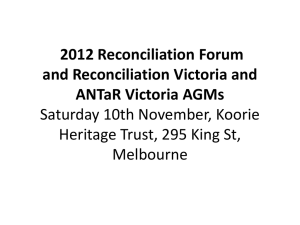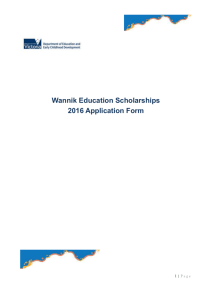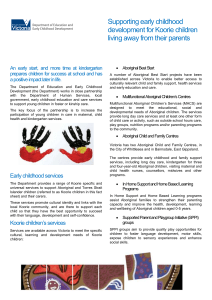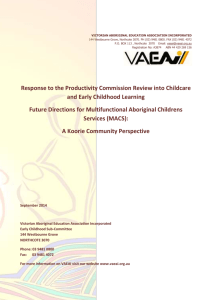Inquiry into language learning in Indigenous communities
advertisement
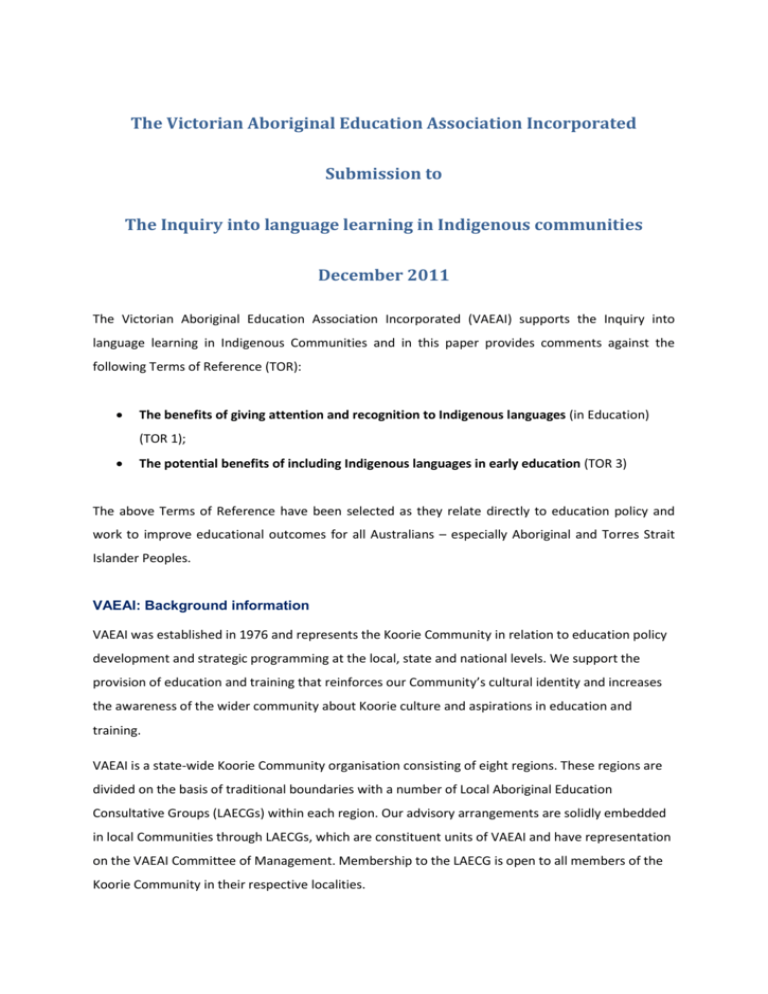
The Victorian Aboriginal Education Association Incorporated Submission to The Inquiry into language learning in Indigenous communities December 2011 The Victorian Aboriginal Education Association Incorporated (VAEAI) supports the Inquiry into language learning in Indigenous Communities and in this paper provides comments against the following Terms of Reference (TOR): The benefits of giving attention and recognition to Indigenous languages (in Education) (TOR 1); The potential benefits of including Indigenous languages in early education (TOR 3) The above Terms of Reference have been selected as they relate directly to education policy and work to improve educational outcomes for all Australians – especially Aboriginal and Torres Strait Islander Peoples. VAEAI: Background information VAEAI was established in 1976 and represents the Koorie Community in relation to education policy development and strategic programming at the local, state and national levels. We support the provision of education and training that reinforces our Community’s cultural identity and increases the awareness of the wider community about Koorie culture and aspirations in education and training. VAEAI is a state-wide Koorie Community organisation consisting of eight regions. These regions are divided on the basis of traditional boundaries with a number of Local Aboriginal Education Consultative Groups (LAECGs) within each region. Our advisory arrangements are solidly embedded in local Communities through LAECGs, which are constituent units of VAEAI and have representation on the VAEAI Committee of Management. Membership to the LAECG is open to all members of the Koorie Community in their respective localities. As VAEAI has grown our functions have been enhanced through a number of policies and strategies, including, Yalca: A Partnership in Education and Training for the New Millennium (2001), Wurreker: The Koorie Community and TAFE in Victoria in Equal Partnership (2000) and Wannik: Learning Together – Journey to Our Future (2008). These developments have ensured that the Koorie Community has a primary role in the development of targeted policies and strategies that will continue to advance Koorie education and training. “The right of Indigenous peoples to education includes the right to provide and receive education through their traditional methods of teaching and learning, and the right to integrate their own perspectives, cultures, beliefs, values and languages in mainstream education systems and institutions. The right to education for Indigenous peoples is a holistic concept incorporating mental, physical, spiritual, cultural and environmental dimensions.” United Nations Expert Mechanism Advice No. 1 (2009) On the Rights of Indigenous Peoples to Education We know that children are ‘sponges’ when it comes to early childhood language acquisition. To not be incorporating bilingual or multilingual language in an early childhood education with bi-lingual and multi-lingual speakers (as is predominantly the case in Australia) is greatly undervaluing the immense potential and capacity of early childhood learners, and their ability to share their knowledge with each other and their early childhood educators. Traditionally in Victoria, generalist early childhood settings have been monolingual establishments – with English the dominant language. While the Commonwealth funded bilingual childcare centres (Greek, Spanish, Vietnamese etc) in the 1980s and 90s, government funding has moved away from supporting bilingual and bicultural programs, in favour of culturally inclusive universal centres – with the exception of the Multifunctional Aboriginal Childcare Services (MACS), which provide a culturally rich education program. We know that during the period from birth to eight years, children experience more rapid brain development and acquire more skills and knowledge than at any other period in their lives. By the time they commence school, children have already developed key communication, learning and thinking skills; learned to build and maintain relationships; and formed a strong sense of their own identity. These skills and knowledge are the foundation for learning at school, and for lifelong learning. It has long been recognised that learning a second language in conjunction with affirmation of the home or heritage language are key factors in positive and successful experiences of school-based language and literacy development; see, for example: www.eduweb.vic.gov.au/edulibrary/public/teachlearn/student/lem/linking.pdf. It is also recognised that for Aboriginal children, a school environment that positively reflects the cultural values learned at home is closely related to regular attendance and achievement. 1 In Victoria, the Department of Education and Early Childhood Development (DEECD) has recently released a resource booklet for learning English as an additional language in the early years.2 It states that ‘In Australia at the present time there are many children starting early childhood services for whom English is not their first or home language. Some early childhood settings have a diversity of languages spoken, while others have only one or two children who do not speak English’. While this booklet is focused around supporting young children from migrant and refugee families, this is equally the case in many regions of Australia with high Aboriginal and Torres Strait Populations, where English is the 2nd, 3rd and even 4th language. Although diversity of language has been long recognised and understood to be relevant to migrant families in Australia, this recognition and understanding has not been equally extended to Aboriginal and Torres Strait Islander families in either Victoria or across Australia. The Victorian Early Years Learning and Development Framework (VEYLDF )3 acknowledges that the families and communities in which children live are diverse, and that children’s learning and development is enhanced when early childhood professionals respect their cultures and ways of knowing and being. In particular, the Victorian Framework recognises and respects Aboriginal cultures and the unique place of these in Victoria’s heritage and future. Learning about and valuing 1 Aboriginal Languages, cultures and reclamation in Victorian schools: standards P–10 and protocols DEECD (2011) Learning English as an Additional Language in the Early Years (birth to six years): Resource Booklet 3 See http://www.vcaa.vic.edu.au/earlyyears/veyldf_for_children_from_birth_to_8.pdf 2 the place of first nations people enhances all children’s sense of place in community.4 By acknowledging each child’s identity, culture and spirituality, and responding sensitively to their emotional states, early childhood professionals build children’s confidence, sense of wellbeing and safety and willingness to engage in learning.5 The Framework (VEYLDF) is based on a set of core principles (effective best practice) which are informed by the latest international evidence regarding the best ways to support children’s learning. The 4th principle is one of Equity and Diversity, and states that: children’s personal, family and cultural histories shape their learning and development. They learn when early childhood professionals respect their diversity and provide them with the best support, opportunities and experiences. The Framework clearly identifies that Early Childhood professionals need to: recognise bi- and multi-lingualism as an asset and support these children to maintain their first language and learn English as a second language • support children’s evolving capacities to learn from birth • ensure that the interests, abilities and culture of every child and their family are understood, valued and respected • maximise opportunities for every child • identify areas where focused support or intervention is required to improve each child’s learning and development • promote cultural awareness in all children, including greater understanding of Aboriginal and Torres Strait Islander ways of knowing and being, and • support children to develop a sense of place, identity and a connection to the land • encourage children as active participants for sustainability, influencing the quality of life now, and for future generations.6 In relation to all sub-points, Koorie children’s learning can be greatly enhanced by incorporating Aboriginal languages and promoting an awareness of Aboriginal English (Koorie English) dialects into the early childhood and school curricula. Despite Victoria having the highest participation rate in languages education of any state or territory, with 21 languages taught in primary school, 17 at secondary school, 14 bilingual programs in 12 government primary schools and 50,000 students studying 45 languages at out-of-school 4 Ibid P. 7 Ibid P.9 6 Ibid P.11 5 classes (community language schools) 7, there are only a small number of regional schools teaching Aboriginal languages – this country’s heritage languages. Although 2012 will see Victorian Aboriginal languages piloted at schools for the very first time, there is great interest and support across local Koorie Communities and schools to have these opportunities extended. Koorie children have as much right as any other child to learn their heritage language, and they have the right – as enshrined in the Universal Declaration on the Rights of Indigenous People – to do this in their own ways and in their own language. We believe strongly that where possible, this should occur in early childhood settings, while children are developmentally at their prime for linguistic inputs and outputs, as well as through their compulsory schooling years. The use of Victorian Aboriginal languages in early and later education sends a strong message to Koorie children that their Community’s language and culture is respected in the Children’s Centre and school. It is VAEAI’s position that teaching and extending children’s knowledge of their own language and culture alongside the wider English-speaking culture will have important positive impacts on Victoria’s Koorie population into the future. 7 The Victorian Government’s Vision for languages education (2011)
